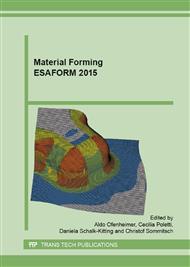p.150
p.156
p.163
p.169
p.175
p.181
p.187
p.193
p.199
Deformation Characteristics of Advanced High Strength Steel under Cyclic Bending and Reversed Bending
Abstract:
In the present study, the Bauschinger effect exhibited in the advanced high strength steel under cyclic bending and reversed bending deformation was examined by both the experimental approach and the finite element analysis. The cyclic tension-compression tests were first conducted for the DP590 steel sheet to determine the material constants required in the Yoshida-Uemori model used in the finite element simulations. Since the deformation mode occurred in the reversed bending tests is similar to that presented in the sheet metal passing across the draw bead or die corner, a three-point reversed bending test apparatus was also developed and the experiments were conducted in the present study. The reversed bending test results clearly demonstrate that the Bauschinger effect presents in the reversed bending process. It confirms that the cyclic reversed bending tests can be applied to examine the Bauschinger effect exhibited in the sheet metal forming process. The finite element analysis was also performed to simulate both the U-hat bending and cyclic reversed bending processes. The comparison of the simulation results with the experimental data reveals that the finite element predictions in both springback and reversed bending load are more accurate if the Yoshida-Uemori model is adopted. It implies that consideration of the Bauschinger effect is necessary in the sheet metal forming if a reversed loading path is present during the forming process.
Info:
Periodical:
Pages:
175-180
Citation:
Online since:
July 2015
Authors:
Price:
Сopyright:
© 2015 Trans Tech Publications Ltd. All Rights Reserved
Share:
Citation:


